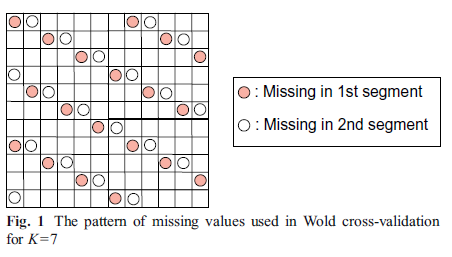PCA에서 최적 PC 개수를 정하기 위한 Cross-validation 방법
1. Row-wise cross-validation
$$ \begin{aligned} CV(k) &= \sum_{i=1}^N \lvert \lvert \mathbf{x}_i - \boldsymbol{\xi} \boldsymbol{f}i^T \lvert\vert^2 \ &= \sum{i=1}^N \lvert \lvert \mathbf{x}_i - \boldsymbol{\xi} (\mathbf{x}_i^T\boldsymbol{\xi})^T \lvert\vert^2 \end{aligned} $$
where $\boldsymbol\xi$ is a PC function(PC loading) with $k$ eigenvectors and $\boldsymbol{f}_i$ is $i$th PC score with $k$ components.
- $\mathbf{x}_i$를 predict하는데 사용 => Overfitting!!
2. Wold cross-validation

-
NIPALS(Non-linear Iterative Partial Least Squares) algorithm을 사용하여 missing data imputation
-
diagonal pattern의 elements $x_{ij}$를 제외하여 “missing value"로 생각하고 cross-validation 진행
-
residual matrix에 PCA를 fit하여 CV error 계산
-
간격 $S$를 결정해줘야함($s,s+S,s+2S,\dots$, $s=1,2,…,S$)
-
Algorithm
-
Initialize residual matrix, $X(1)=X$.
-
Calculate the sum of squared elements $$ SS_{X(k)} = \sum_i\sum_j x_{ij}^2(k) $$
-
Calculate CV error using the residuals $X(k)$ left-out segment, $s$ $$ CV(k) = \sum_i \sum_j (x_{ij}(k) - \hat x_{ij}(k))^2 $$ where $\hat x_{ij}(k) = \xi_i f_j^T$, $\xi_i$ is $i$th row of $\boldsymbol{\xi}^{(-s)}$ and $f_j$ is $j$th row of $\boldsymbol{f}^{(-s)}$.
-
Validate the dimension $k$ $$ R(k) = \frac{CV(k)}{SS_{X(k)}} $$
- If $R<1$, predictions are improved.
- If $R>1$, predictions does not improved, so the best number of components is $k-1$
-
Recalculate the residuals $X(f)$ using the complete data matrix $X$, and iterate the algorithm with increasing $k=k+1$.
-
-
단점
-
CV error 계산과정에서 $k-1$까지의 residual을 사용하여 $k$th error 계산
=> $k-1$ components PCA model에 dependent($x_{ij}$가 model에 포함)
=> Overfitting
-
3. EK cross-validation(Eastment and Krzanowski)
-
Overfitting 방지를 위해 prediction과 assessment stage에 each data point를 사용하지 않도록 함
-
Procedure
-
$x_{ij}$를 cross-validation하기 위해 2개의 PCA model를 fit

-
$i$th row를 제외한 PCA model $$ \mathbf x^{(-i)} = \mathbf{U}^{(-i)} \mathbf{S}^{(-i)} \mathbf{V}^{(-i)T} $$
-
$j$th column을 제외한 PCA model $$ \mathbf x^{(-j)} = \mathbf{U}^{(-j)} \mathbf{S}^{(-j)} \mathbf{V}^{(-j)T} $$ => $x_{ij}$와 independent
-
-
Proposed method to combine 2 models by Eastement and Krzanowski $$ \hat{x}_{ij}(k) = \sum^k u_i^{(-j)}(k)\sqrt{s^{(-j)}(k)} \sqrt{s^{(-i)}(k)} v_j^{(-i)}(k) $$
-
Calculate CV error $$ CV(k) = \frac{1}{IJ} \sum_i \sum_j \left( \hat x_{ij}(k) - x_{ij} \right)^2 $$
-
Compare the model complexity $$ W(k) = \frac{CV(k-1) - CV(k)}{df_{fit}(k)} \big/ \frac{CV(k)}{df_r(k)} $$ where $df_{fit}(k) = I+J-2k$ is the number of degrees of freedom lost in fitting the $k$th components and $df_r(k)$ is the number of degrees of freedom remaining after fitting $k$ components.
-
Choose the $k$ such that $W(k)>1(\text{or }0.9)$.
-
-
단점
- 각각 다른 subset에서 parameter를 estimate하기 때문에, true value와 다른 parameter를 estimate하게 된다.
4. Eigenvector cross-validation
-
LOOCV 방법을 사용
-
missing data problem (한 변수가 missing인 데이터와 이 데이터로 만들어진 model로 missing variable을 예측하는 문제)
-
Procedure
-
Apply PCA on data $X^{(-i)}$ left-out $i$th row.
-
For the left-out variables, $j=1,2,\dots, J$
-
Estimate the score (Least squares form) $$ \boldsymbol{f}^{(-j)T} = \mathbf{x}_i^{(-j)T} \boldsymbol{\xi}^{(-j)} \big( \boldsymbol{\xi}^{(-j)T}\boldsymbol{\xi}^{(-j)} \big)^{-1} $$
-
Estimate the element $x_{ij}$ $$ \hat{x}_{ij}(k)=\boldsymbol{f}^{(-j)} \boldsymbol{\xi}_j^T $$
-
Calculate CV error $$ CV(k) = \sum_i \sum_j (x_{ij} - \hat{x}_{ij}(k))^2 $$
-
-
Iterate $i=1,2,\dots,I$.
-
-
$x_{ij}$ and $\hat{x}_{ij}$ are actually independent.
5. EM cross-validation
- Overfitting을 일으키는 다음의 2가지 원인을 제거 가능
- predicted value와 left-out element간의 dependence
- method가 정확하지 않아서 발생한 error
6. EM-Wold cross-validation
-
Improved version of Wold cross-validation
-
각 segment의 components를 동시에 estimate함으로써 Wold CV의 문제점 해결
-
NIPALS algorithm으로 missing data를 다루는 것이 더이상 불가능
-
Imputation을 통해 PCA fit 가능
-
Element-wise computation (row-wise or column-wise X)
-
Procedure
-
For left-out element $s=1,\dots,IJ$
-
Split data into $X^{(-s)}$ and $x^{(s)}$.
-
Fit a PCA model by solving $$ \min\lvert\lvert \mathbf{X}^{(-s)} - \boldsymbol{f} \boldsymbol{\xi}^T \lvert\lvert^2_k $$
-
Find the predicted data matrix as $$ \hat X(k) = \boldsymbol{f} \boldsymbol{\xi}^T $$
-
Calculate CV error $$ CV(k) = \frac{1}{IJ} \sum_s(x_s - \hat x_s(k)) $$
-
-
7. EM-EK cross-validation
-
Improved version of EK cross-validation
-
predicted matrix as $$ \hat X = \bigg( \mathbf{U}^{(-j)} \big(\mathbf{U}^{(-j)} \big)^+ \bigg) X^{(-ij)} \bigg( \mathbf{V}^{(-i)} \big(\mathbf{V}^{(-i)} \big)^+ \bigg)^T $$
-
EM algorithm으로 missing data imputation
Reference
- R. Bro et al. (2008), Cross-validation of component models: A critical look at current methods. Analytical and Bioanalytical Chemistry, 390, 1241-1251.
- How to perform cross-validation for PCA to determine the number of principal components?
- How to cross-validate PCA, clustering, and matrix decomposition models
